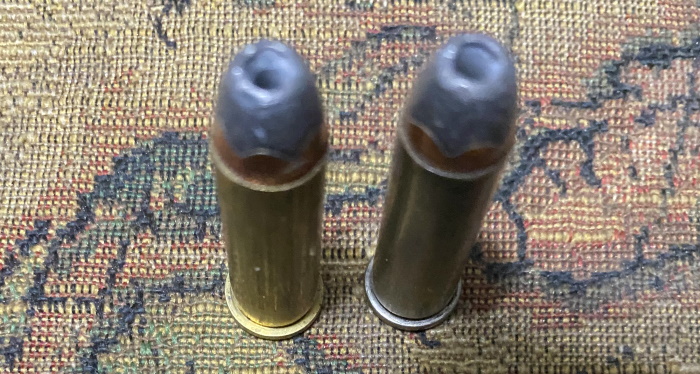Early in the pandemic I experimented with modifying bullets into effective hollow-points for self-defense. These were primarily for 9mm, and I experienced some success. You can read about that here.
While the 9mm bullets were functional attempting to use them in the lower-velocity .38 Special was a failure, which was not unexpected. But my interest was rekindled today. I was at Pinto’s and on their clearance table found some Remington 125gr. JHP bullets for .357 Magnum. With nearly half the bullet being exposed soft lead I had some hope they might function in .38 Special.
On arriving home I took them to the reloading bench and looked them over, and on examination I felt little hope that they would expand at .38 Special velocities. I loaded a few over 6.0gr. of Universal, which is rather peppy but is by no means a +P load.

It occurred to me to have a go at modifying these using the device I had set up for my previous experiments, and after rummaging around a bit I found it and set about putting it to use.
In the photo above you can see the ram on the top-left. This is inserted in the reloading press in place of a shell-holder. The swaging probe (top-center) is inserted in the die. I place a bullet on the ram and run it up into the die where it encounters the probe which reshapes the hollow-point into a larger, more suitable shape. After adjusting the die and a bit of fiddling I had produced some much more satisfactory bullets.
I ran off a batch of the modified bullets and loaded them as well. Setting up my Clear ballistics gel blocks, which sadly are rather badly darkened from re-use so wound-tracks cannot be photographed usefully. I also set up my Caldwell Chronograph but even with it’s onboard LED lighting there was not sufficient light to get a good reading. I seriously doubt the bullets were travelling either 6,333 fps or 192 fps. I expect from the available data when fired from the sub-two inch barrel of my S&W Model 642 the bullets are likely travelling in the neighborhood of 750-800 fps.
Initially I did not fire through denim, having no ideal if they would expand or not. I fired five rounds into the gel (hoping to get a good reading from the chronograph.) Examining the gel I found that most of the bullets had stopped between 9-10″, excepting the single bullet that had not expanded. This bullet was found back-forward at 14″.
The two bullets with the greatest and most uniform expansion averaged about .6″ in diameter. The center bullet struck the base of another bullet, but the normally expanded area was around .525″The bullet that expanded slightly (center-left) expanded to .46″ and the bullet found facing backwards at 14″ shows only slight expansion of the hollow cavity. Having received such relatively promising results on bare get I fired two more shots through 4 layers of denim.
Both of these bullets expanded and penetrated 10-11″ into the gel. The bullet on the left expanded to .458″ and the bullet on the right expanded to .526″. I find this quite respectable from a 1-7/8″ barrel, especially from a standard-pressure load!
Now these loads do not quite meet FBI standards for duty loads. Fortunately I am not an FBI agent. and am unlikely to need the precise levels of performance they require in the course of their duties. I am quite happy with these loads, and feel fully confident in them for use as reloads for a compact carry revolver.
I should note that while they have a rather loud report recoil was not at all objectional, even from the light-weight alloy snubby.
Stay safe and take care,
Michael Tinker Pearce, April 9, 2022